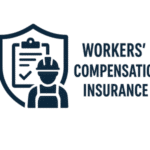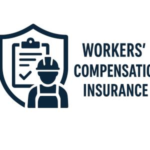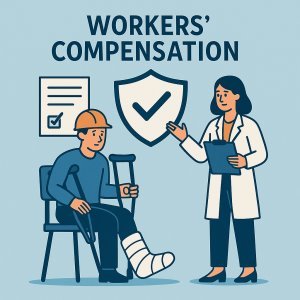
Workers Compensation for 1099 Independent Contractors & Subcontractors
July 18, 2025
Capturing Workers Comp Savings Through Loss Control Partnerships
July 22, 2025In the intricate landscape of employee benefits, few topics spark as much confusion as the relationship between workers’ compensation and disability insurance. Both promises of support in times of adversity, they often blur together in the minds of employees and employers alike. Yet, beneath their seemingly similar facades lies a complex dance-sometimes harmonious, sometimes contentious. Are these two forms of coverage complementary allies in safeguarding income and well-being, or do they represent conflicting forces vying for priority and payment? This article navigates the nuanced interplay between workers’ comp and disability insurance, shedding light on how they intersect, diverge, and ultimately serve-or complicate-the financial security of the workforce.
Table of Contents
- Understanding the Core Differences and Overlaps Between Workers Comp and Disability Insurance
- Navigating Eligibility and claim Processes for Optimal Benefits
- Strategies for Coordinating Workers Comp and Disability Insurance Effectively
- Recommendations for Employers and Employees to Maximize Coverage and Minimize Gaps
- Q&A
- In Conclusion
Understanding the Core Differences and Overlaps Between Workers comp and Disability Insurance
At their core, workers’ compensation and disability insurance serve distinct but sometimes intersecting purposes. Workers’ comp is a no-fault system designed specifically to address injuries or illnesses directly related to an employee’s job. It covers medical expenses,rehabilitation costs,and a portion of lost wages,ensuring that workers harmed on the job receive timely support without proving employer negligence. Conversely, disability insurance generally covers a broader spectrum of disabling conditions, including non-work-related illnesses or injuries, providing income replacement during periods an individual cannot work due to any disability.This essential difference highlights why one focuses narrowly on occupational hazards while the other offers more global protection.
Despite these clear distinctions, there are intriguing overlaps and moments of confusion where the lines blur. For example, an employee injured at work might first file a workers’ comp claim but also have access to short- or long-term disability benefits to supplement income, especially if workers’ comp indemnity payments do not fully replace lost wages. Consider the following contrasts and intersections:
| Feature | Workers’ Compensation | Disability Insurance |
|---|---|---|
| Coverage Cause | Work-related injuries/diseases | Any illness or injury, including non-work related |
| Medical Expense Coverage | Yes | Typically no, focuses on income |
| Income Replacement | Partial, often limited to a percentage | Percentage of salary, varies by policy |
| Legal Requirement | Mandated by law for employers | Optional, purchased by individual or employer |
Navigating Eligibility and Claim Processes for Optimal Benefits
understanding the nuances between workers’ compensation and disability insurance is critical for ensuring you receive the full scope of benefits available. Each program has its own eligibility criteria and claim procedures that, when navigated effectively, complement rather than conflict wiht each other. For instance, workers’ compensation typically requires proof that the injury or illness arose directly from job duties, while disability insurance focuses on your inability to perform regular work tasks regardless of cause. Recognizing these differences early can streamline your applications and prevent delays.
To optimize the claims process, it helps to break down the key steps for each type of benefit:
- Workers’ Compensation: Report injury promptly, gather medical documentation, and file a claim with your employer’s insurance carrier.
- Disability Insurance: Provide thorough medical evidence of your inability to work and submit claims to your insurance provider.
- Overlap Strategy: In cases where both apply, coordinate documentation to avoid conflicting statements and use the benefits sequentially if allowed.
| Benefit Type | Primary Eligibility | Claim Focus |
|---|---|---|
| Workers’ Compensation | Injury tied to workplace | Medical & employer verification |
| Disability Insurance | Work incapacity from any cause | Medical certification & income loss |
Strategies for Coordinating Workers Comp and Disability Insurance Effectively
Effectively managing workers comp and disability insurance requires a strategic approach to avoid redundancy and maximize benefits. One of the key tactics is to maintain clear interaction channels between your HR department, insurance providers, and employees. This ensures that everyone understands the scope and limits of each coverage. Additionally, documenting each claim meticulously helps in coordinating timelines and preventing overlaps that might delay compensation. Emphasize the importance of understanding the waiting periods and eligibility criteria for both benefits, since this can considerably influence the claimant’s financial stability during recovery.
Employers can also adopt integrated case management systems that track claims and manage the interplay between workers comp and disability insurance more seamlessly. These systems provide real-time updates and flag potential conflicts before they escalate. Consider the following practical steps for coordination:
- Establish standardized claim review processes to assess the relevance and priority of each insurance claim.
- Train staff to recognize differences and intersections between the two policies for efficient claims handling.
- Utilize cross-functional teams including legal,medical,and HR experts to create comprehensive return-to-work plans.
- Regularly review and update insurance policies to keep pace with changing regulations and workforce needs.
| Strategy | Benefit | Potential Challenge |
|---|---|---|
| Centralized Communication | Reduces delays | requires training |
| Integrated Claim Tracking | Prevents benefit overlap | Initial setup cost |
| Cross-functional teams | Holistic support | Coordination complexity |
Recommendations for Employers and Employees to Maximize Coverage and Minimize Gaps
To ensure both workers comp and disability insurance work seamlessly together, employers should take a proactive role in educating their workforce and crafting policies that clarify coverage boundaries. Open communication channels about what each insurance covers can help reduce confusion when claims arise. Employers are encouraged to:
- Provide regular training sessions on the differences and overlaps between workers comp and disability insurance.
- Coordinate with insurance providers to streamline claim processes and avoid duplicate benefits.
- Implement clear internal protocols that guide employees on reporting injuries and filing claims promptly.
Employees, on their part, must be diligent in understanding their rights and responsibilities.Awareness and timely action are critical to minimizing coverage gaps. Essential steps for employees include:
- Reviewing policy documents thoroughly and seeking clarification when needed.
- Promptly reporting work-related injuries or disabilities to employers as per company policy.
- Keeping detailed records of medical visits and communications with insurance representatives.
| Action | Recommended Party | Benefit |
|---|---|---|
| Educate on coverage distinctions | Employers | Reduces claim confusion |
| Prompt injury reporting | Employees | Ensures faster claim processing |
| Coordinate claim procedures | Employers | Minimizes benefit duplication |
| Maintain detailed records | Employees | Supports evidence in claims |
Q&A
Q&A: Workers Comp vs Disability Insurance - Complement or Conflict?
Q1: What is the fundamental difference between workers’ compensation and disability insurance?
A: Workers’ compensation is a state-mandated benefit designed to cover medical expenses and lost wages for injuries directly caused by work-related activities. disability insurance, on the other hand, offers broader protection by providing income replacement if you’re unable to work due to any illness or injury, whether on or off the job.
Q2: Can someone receive both workers’ comp and disability insurance benefits at the same time?
A: Generally, yes, but with crucial caveats. Workers’ comp benefits typically take precedence when an injury is work-related. Disability insurance may cover gaps that workers’ comp doesn’t, such as partial wage replacement or coverage after workers’ comp runs out. Though, benefits can’t be “stacked” in a way that results in getting paid more than your actual lost income.
Q3: Do workers’ comp and disability insurance ever conflict?
A: Conflicts can arise, especially around eligibility and payment coordination. As a notable example,disability insurance providers may question claims if workers’ comp is paying,or vice versa. Determining whether an injury qualifies as work-related sometimes sparks disputes, delaying benefits. Navigating these nuances requires careful documentation and sometimes legal advice.Q4: How do these two types of coverage complement each other?
A: They form a safety net that addresses different risks. Workers’ comp zeroes in on occupational hazards, often covering full medical bills and a meaningful portion of lost wages. Disability insurance fills in when you face non-work-related disabilities or when workers’ comp benefits are capped or exhausted. Together, they help ensure continuous income protection.
Q5: who should consider having both workers’ comp and disability insurance?
A: Nearly every worker benefits from workers’ comp, as it’s typically required by law.Disability insurance is especially useful for those seeking additional financial security, such as self-employed individuals, freelancers, or employees with limited workers’ comp coverage. It’s also valuable for anyone wanting coverage beyond workplace injuries.
Q6: What should employees do if they’re injured on the job in terms of these coverages?
A: Immediately report the injury to your employer to initiate workers’ comp claims. Together, review your disability insurance policy to understand your rights and benefits. Keep thorough records of your medical treatments and communications, and consider consulting a benefits expert or attorney if complications arise.
Q7: Is one type of coverage generally better than the other?
A: They serve different purposes,so it’s not about better or worse but about complementarity. workers’ comp is mandatory and typically covers medical treatment fully for work-related injuries, but may have wage replacement limits. Disability insurance offers broader illness and injury protection but often with waiting periods and coverage limits. The best strategy is combining both for robust protection.
Q8: Can employers influence which benefits workers receive?
A: Employers primarily provide workers’ comp as part of legal compliance, but disability insurance offerings vary-some employers include them as perks, while others leave it up to employees. It’s critically important for workers to understand their benefits packages and consider private disability insurance if coverage is insufficient.
Q9: How do jurisdictional differences affect workers’ comp and disability insurance?
A: Workers’ comp laws and benefits vary widely by state,affecting eligibility,benefit amounts,and claim procedures. Disability insurance, notably short-term and long-term policies, are often standardized by the insurer but can also be influenced by state regulations. Always review local laws and insurance terms carefully.
Q10: What’s the takeaway for readers trying to understand workers’ comp versus disability insurance?
A: Think of workers’ comp and disability insurance as two intertwined threads in the fabric of workplace protection. One is compulsory and focuses on on-the-job injuries; the other is voluntary and covers a wider range of health issues. Together, they mitigate financial risk, but understanding their boundaries ensures you’re not caught off guard when life throws a curveball.
In Conclusion
in the intricate dance between Workers’ Compensation and Disability Insurance, understanding their unique steps helps employees and employers alike move with greater confidence.While they may occasionally cross paths or seem at odds, these programs often work best as partners-each filling gaps the other leaves behind. navigating their intersections thoughtfully ensures that when life takes an unexpected turn, the safety net beneath is as sturdy and inclusive as possible. Ultimately, whether complement or conflict, these systems remind us that protecting the workforce requires both clarity and collaboration.
“This content was generated with the assistance of artificial intelligence. While we strive for accuracy, AI-generated content may not always reflect the most current information or professional advice. Users are encouraged to independently verify critical information and, where appropriate, consult with qualified professionals, lawyers, state statutes and regulations & NCCI rules & manuals before making decisions based on this content.”







